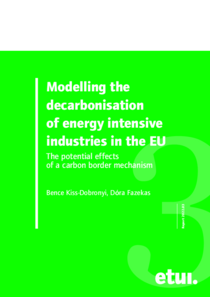Modelling the decarbonisation of energy intensive industries in the EU: the potential effects of a carbon border mechanism

Kiss-Dobronyi, Bence ; Fazekas, Dóra
European Trade Union Institute, Brussels
ETUI - Brussels
2022
33 p.
energy ; decarbonization ; climate change ; economic impact ; labour market ; gas emission
Report
2022.03
Environment
English
Bibliogr.
978-2-87452-635-0
16-68485
"The main aim of the analysis is to provide evidence on the labour market and economic impacts of different decarbonisation pathways for the basic metals, chemicals and minerals sector, as a part of EII, and for the wider economy, considering also the expected effects of a carbon border adjustment mechanism (CBAM).
The E3ME macroeconometric model maintained by Cambridge Econometrics was used to simulate the direct and indirect effects of transition in this sector as well as to give insights into the induced effects such as: the impact on the economy of supply chain effects and changing energy demand from EII sectors; the spillover effects in other sectors from potential lay-offs or sectoral transformation; and the socioeconomic impacts that arise from changing Emissions Trading System (ETS) revenues.
Three scenarios were designed, representing alternative decarbonisation pathways for each industry based on different assumptions; namely, the type and share of technologies adopted and the time profile and costs of emissions abatement. The study also analysed the proposed CBAM and its effects in interaction with the different decarbonisation pathways.
This paper summarises the EU27 results from the E3ME modelling exercise which analyses the impacts of the sectoral decarbonisation scenarios for energy intensive industries. These scenarios are defined on top of a reference scenario that is already aiming to reach economy-wide net zero emissions by 2050, therefore limiting global warming to 1.5C by the end of the century. The sectoral pathways aim to contribute to this by eliminating emissions from EII by 2050.
After a brief overview of the scenarios under the E3ME model, a discussion of the results follows. This focuses on employment at EU27 level as well as on the differences between the Member States."
Digital;Paper
ISBN (PDF) : 978-2-87452-636-7
Legal deposit : D/2022/10.574/29
The ETUI is co-funded by the European Union. Views and opinions expressed are however those of the author(s) only and do not necessarily reflect those of the European Union or the ETUI.